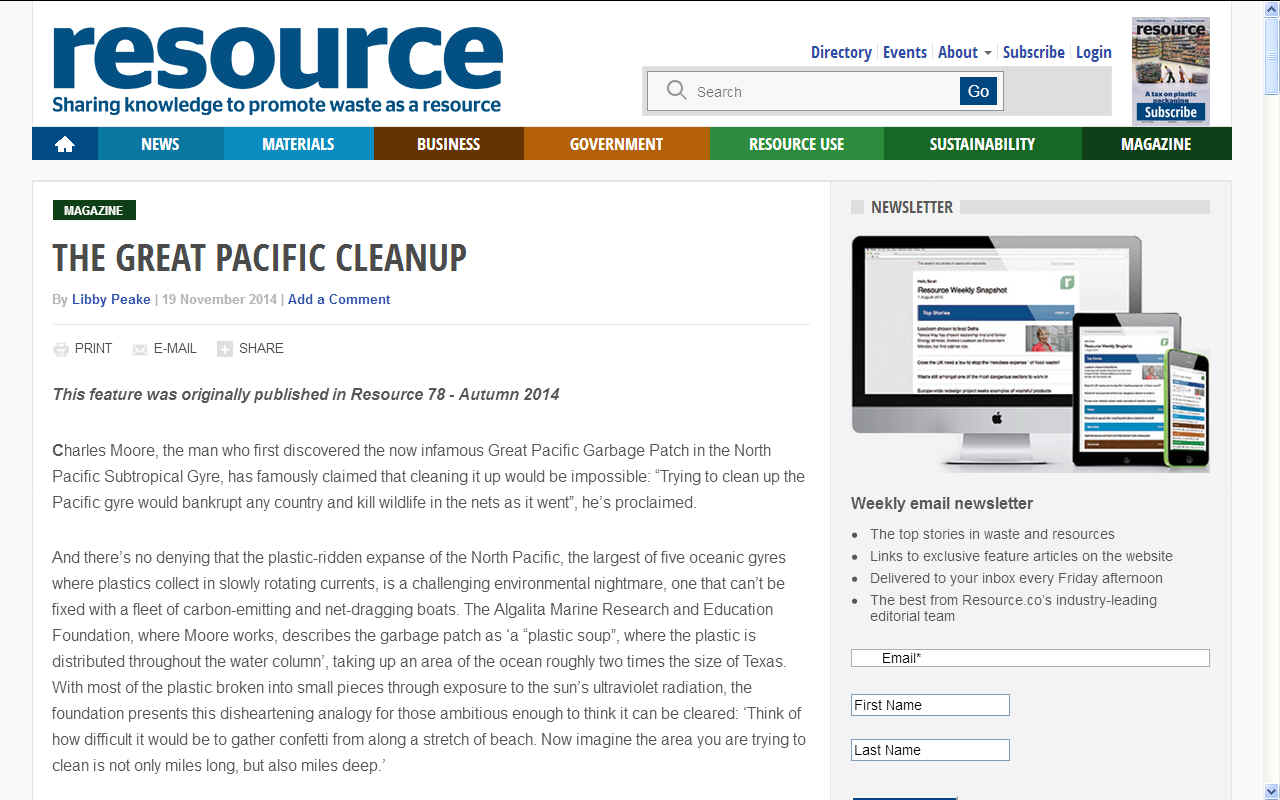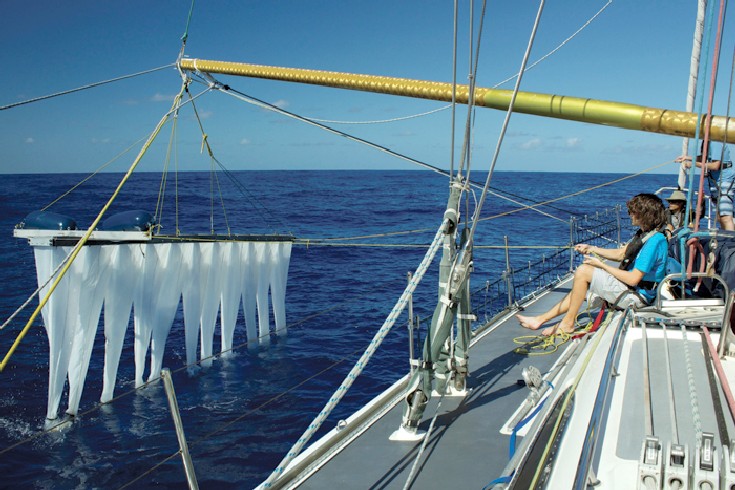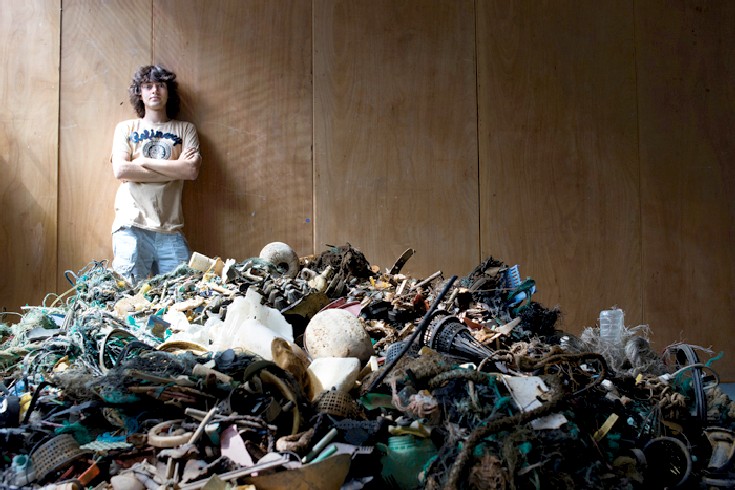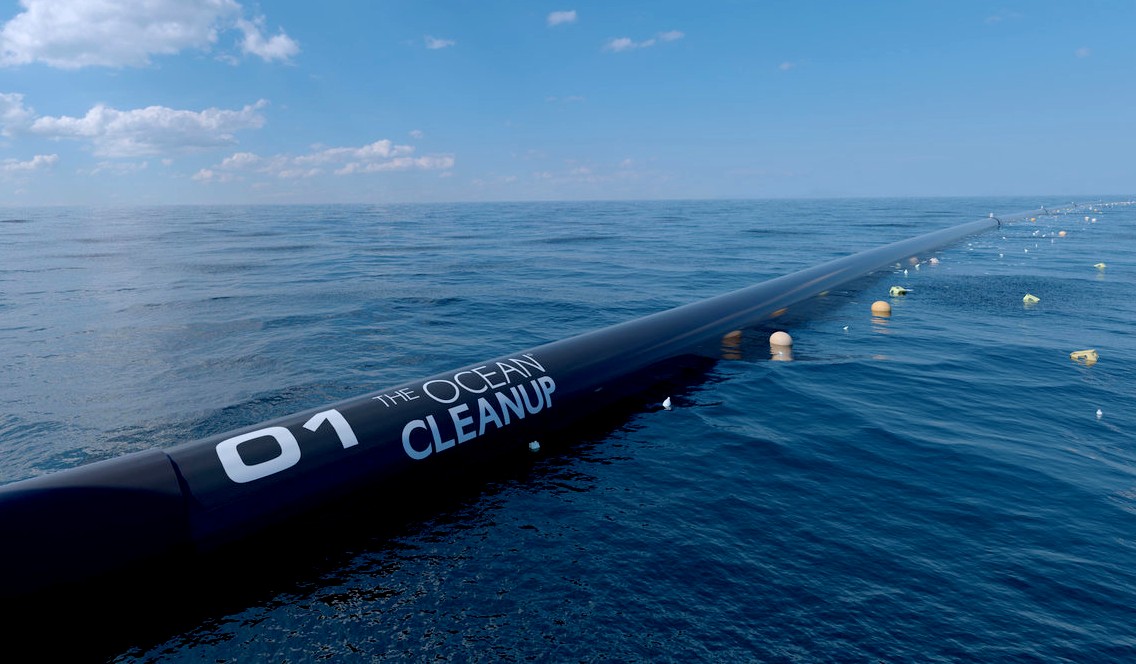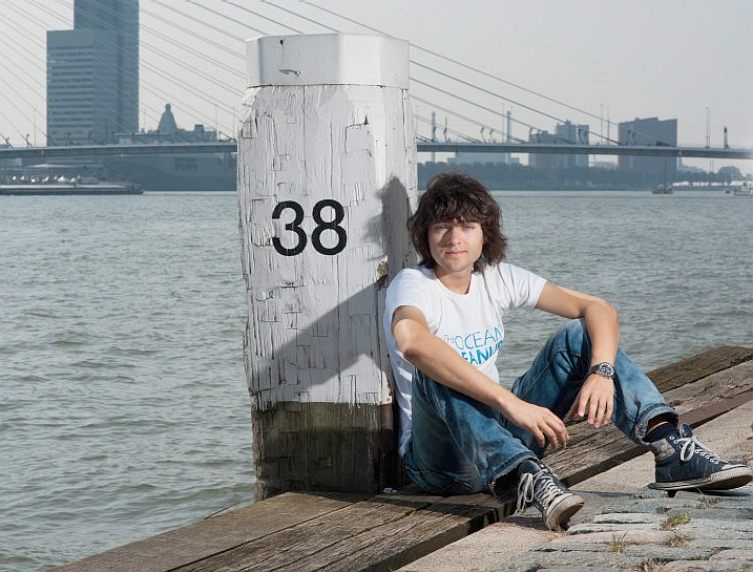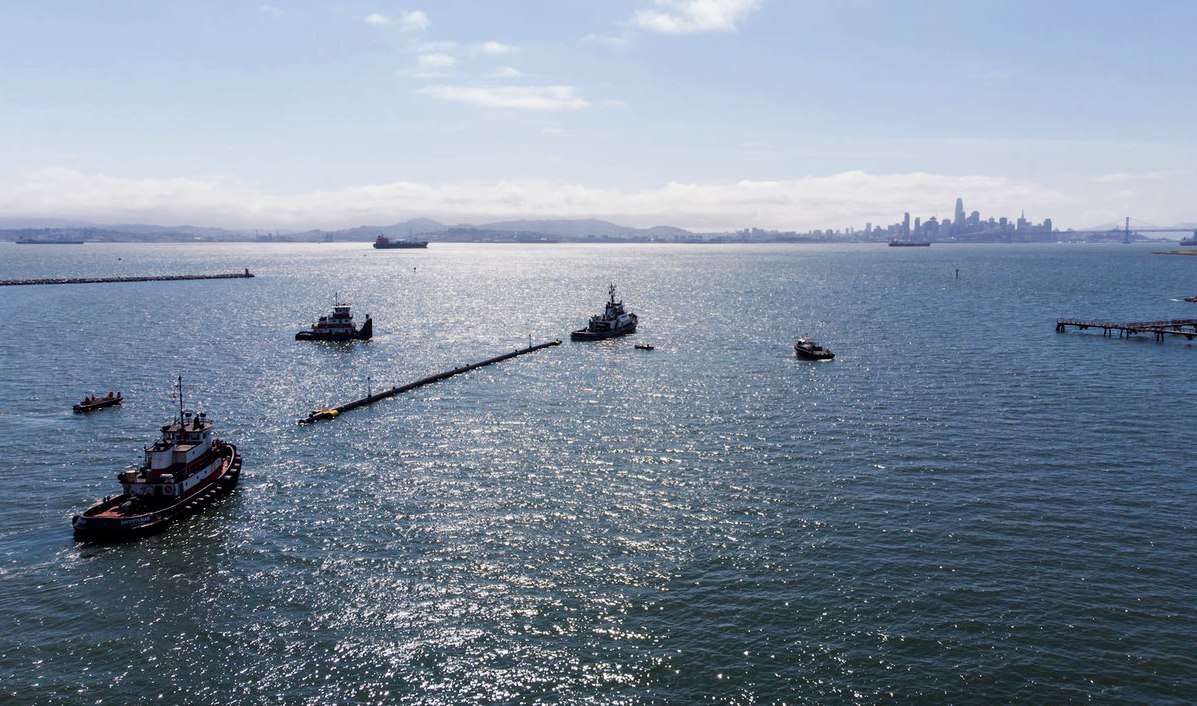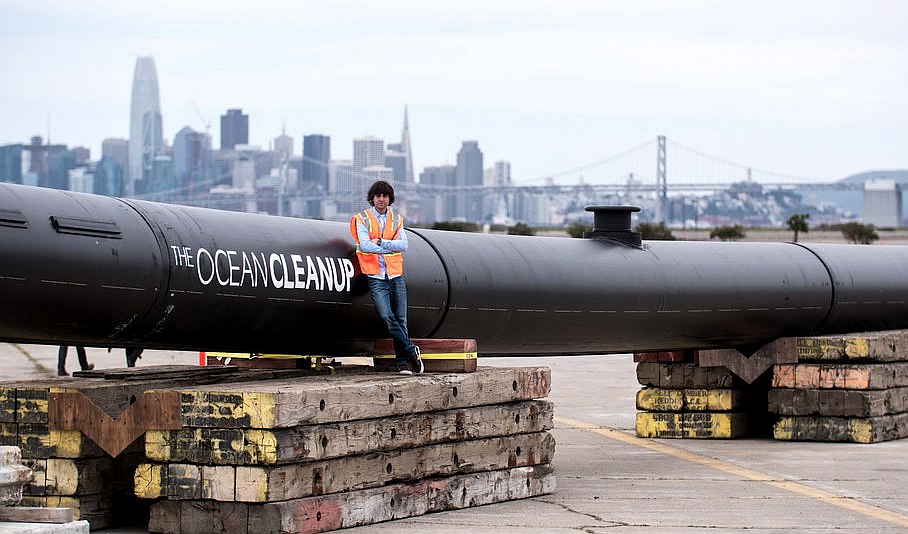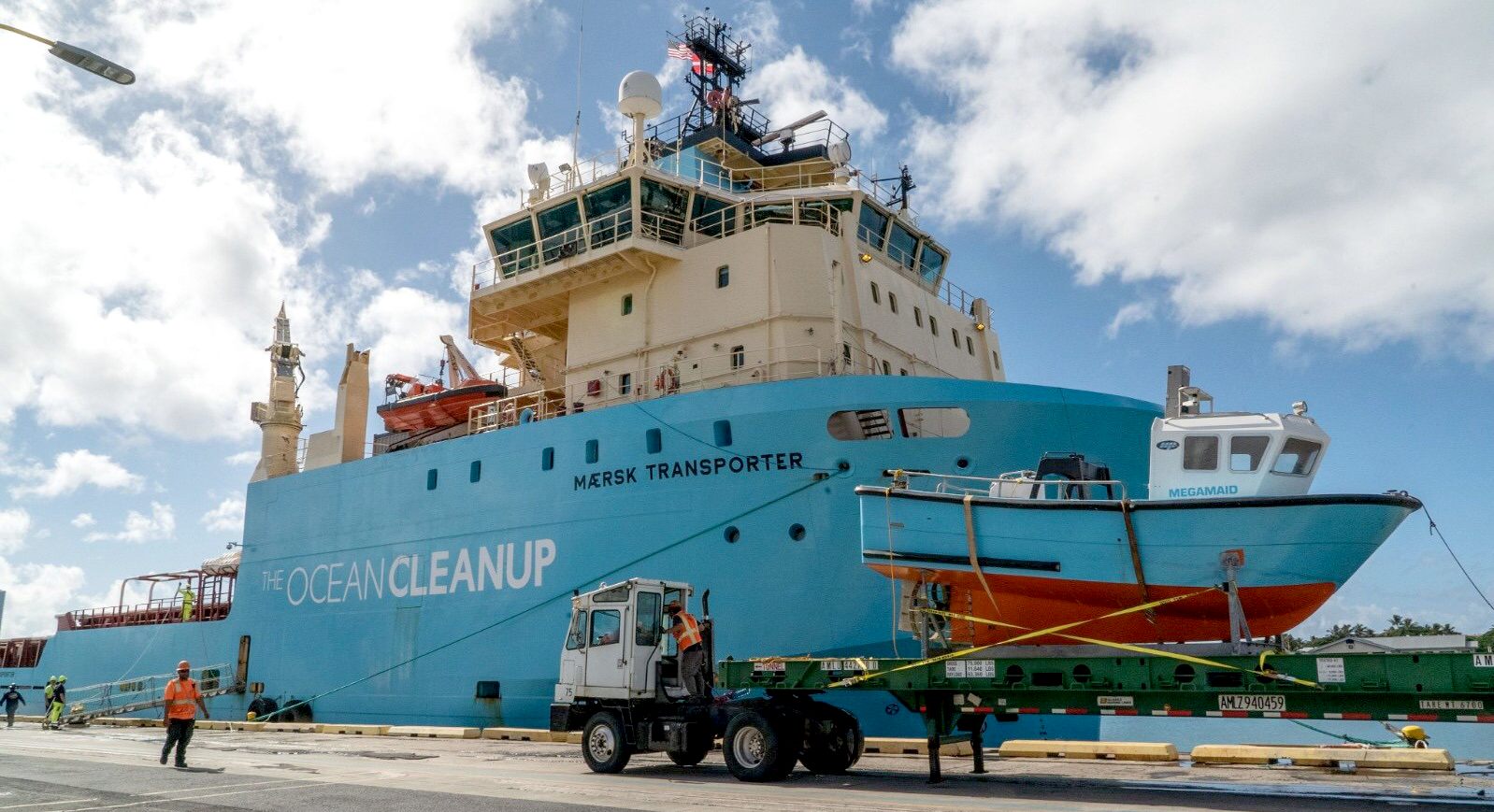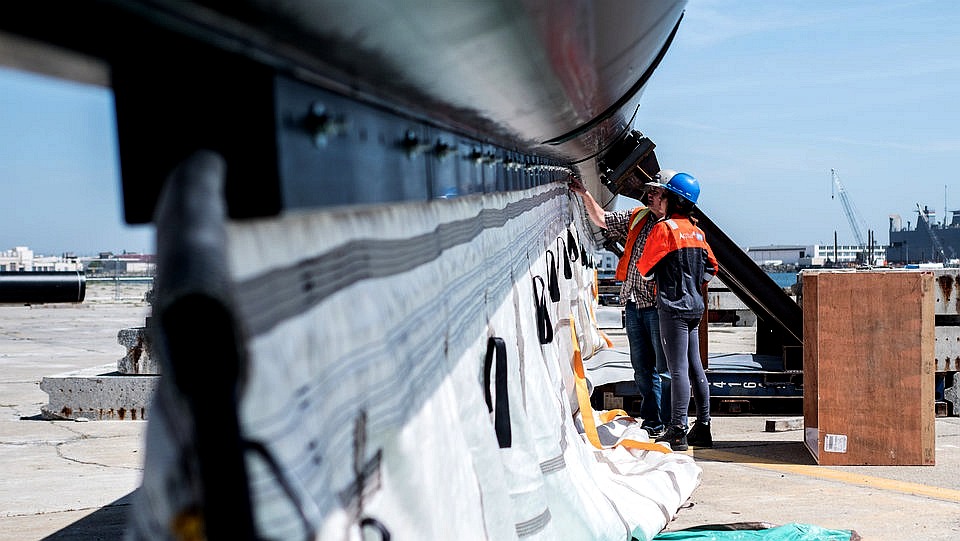|
2014 THE OCEAN CLEANUP PROJECTS
PLEASE USE OUR A-Z INDEX TO NAVIGATE THIS SITE
|
|
In 2014, the boom design was revised, replacing the central platform with a tower detached from the floating barriers. This platform would collect the plastic using a conveyor belt. The floating barrier was proposed to be 100 km long. In 2015, this design won the London Museum Design of the Year and the INDEX: Award.
RESOURCE 19 NOVEMBER 2014 - THE GREAT PACIFIC CLEANUP
Charles Moore, the man who first discovered the now infamous Great Pacific Garbage Patch in the North Pacific Subtropical Gyre, has famously claimed that cleaning it up would be impossible: “Trying to clean up the Pacific gyre would bankrupt any country and kill wildlife in the nets as it went”, he’s proclaimed.
And there’s no denying that the plastic-ridden expanse of the North Pacific, the largest of five oceanic gyres where plastics collect in slowly rotating currents, is a challenging environmental nightmare, one that can’t be fixed with a fleet of carbon-emitting and net-dragging boats. The Algalita Marine Research and Education Foundation, where Moore works, describes the garbage patch as ‘a “plastic soup”, where the plastic is distributed throughout the water column’, taking up an area of the ocean roughly two times the size of Texas. With most of the plastic broken into small pieces through exposure to the sun’s ultraviolet radiation, the foundation presents this disheartening analogy for those ambitious enough to think it can be cleared: ‘Think of how difficult it would be to gather confetti from along a stretch of beach. Now imagine the area you are trying to clean is not only miles long, but also miles deep.’
The photodegraded plastic, which outnumbers plankton by a ratio of six to one, is often mistaken as food by marine life and, even when it doesn’t directly kill those that ingest it (and it reportedly kills at least a million sea birds and hundreds of thousands of marine mammals each year), it can enter the food chain, bringing with it a whole host of undesirable chemicals – hormone disrupters like bisphenol A and potential carcinogens like styrene monomers – that the plastic releases as it degrades, as well as hydrophobic fertilizers and herbicides that it absorbs in the marine environment.
It’s a bit of an overwhelming problem, and, with environmental dilemmas like this, “the common response is ‘Well, that’s a long way off. That’s for our children to worry about’”, according to Boyan Slat. Speaking in the video of his TEDx talk in his home city of Delft, Netherlands, Slat follows that assertion with a cheeky grin and the statement: “Hello. Here I am.”
At the time of giving his talk, Slat was just 17 years old and was presenting his concept for a passive oceanic cleanup system, which grew out of a high school science project. Slat explains: “I realised, back in high school, that there might be an alternative [to a cleanup process based on vessels with nets that would be fishing for plastic]. I wondered: why move through the oceans if the oceans can move through you? Instead of going after the plastics, you could simply wait for the plastic to come to you, without requiring any added energy. An array of floating barriers would first catch and then concentrate the debris, enabling a platform to efficiently extract the plastic afterwards. The ocean currents would pass underneath these barriers, taking… sealife with it, preventing by-catch. An elegant idea. But when I got asked to present this idea at the TEDx Delft conference, it wasn’t much more than that – an idea.”
LIMITATIONS
-
Though The Ocean Cleanup estimates it can collect the majority of plastic mass from the world’s oceanic gyres, it does not think it can collect any microplastics, particles less than five millimetres (mm) (or even one mm, according to some researchers). In fact, under the modelled conditions, no plastics smaller than two centimetres were captured.
After presenting his idea at TEDx, Slat started studying aerospace engineering, but, he says he couldn’t stop thinking about ocean plastics and so turned to professors and industry experts to help compile a list of 50 questions that needed to be answered to call his idea a feasible solution. He subsequently suspended his studies to set up The Ocean Cleanup foundation, and used crowdfunding and the work of many volunteers and professionals in many fields – including ecology, engineering, fluid dynamics, plastic processing and maritime law – to conduct an extensive feasibility study into the idea. This summer, the foundation released a 530-page report claiming that the idea is indeed feasible.
“The basic concept and all the basic principles – so, the catching of the plastics, the concentration of the plastics – haven’t changed and have in fact now been validated, but what has changed now is some of the details”, Slat tells me, adding: “For example, how the mooring systems work, what the platform looks like – at first it looked like a fancy UFO crashed into the ocean; it now more closely resembles an oil rig. Basically, when I made these concept designs, I didn’t have any knowledge whatsoever, there was no one helping me three years ago. Now, fortunately, having worked with a team of 100 people, including 70 scientists and engineers – we’ve been able to develop this.”
It’s mainly the details that have changed, and, Slat says, they now have more accurate estimates for many aspects of the project. The study conservatively estimates that there are 140,000 tonnes of plastic floating in the North Pacific gyre – 119,000 tonnes of particles larger than two centimetres and 21,000 tonnes smaller than two centimetres. Most of this plastic, according to the study, is concentrated close to the surface of the water, with mass decreasing exponentially with depth, leading to the conclusion that the floating barriers should be placed at a depth of two to three metres to collect the greatest mass of plastic pollution.
The design of these floating booms has also changed, as tests found that long booms with high tension wouldn’t be able to work with the movements of the waves, and in fact could ‘overtop’, likely losing some of the plastic collected. The Ocean Cleanup has attempted to address the problem with a design that sees boom and tension cable separated, with booms connected to the cable every 60 metres. The booms are comprised of floating buoyancy elements with weighted ‘skirts’ – thin, impermeable and flexible sheets that direct the plastics – hanging to a depth of two to three metres. They will be positioned in a ‘V’ shape, and angled toward a central platform with the aim of concentrating the plastic; the models show that 80 per cent of the plastic that encounters the booms will be captured. It will then collect at the moored processing platforms that Slat says look like oil rigs (though some might think they’re remarkably like air traffic control towers anchored to the sea floor), from which it will have to be picked up by ship every 45 days.
Slat explains that this system is highly scalable and that the percentage of plastics that it can capture depends on the scale of deployment: “If you deploy a single system with a length of a hundred kilometres, you would collect 42 per cent of the plastic in the Great Pacific Garbage Patch, where about a third of all plastics from all oceans combined can be found. But if you deploy something that’s, say, 200 kilometres, you would collect about two-thirds of the Great Pacific Garbage Patch. If you use a hundred-kilometre device and deploy it for 20 years, you would collect about 75 per cent, so it really depends on these variables. We can say that the majority of plastics in this area can be collected using this system.”
And it’s not just the collection of plastic that the foundation is looking into – it’s also considering what to do with the harvested material. The feasibility study involved collecting half a tonne of plastic from a remote Hawaiian beach, considered to be a ‘representative’ sample of gyre debris. This waste was tested by pyrolysis companies, which found that ‘the quality of the pyrolysis oil obtained from the polyolefin fraction of marine debris is comparable to that obtained as regular input in their pyrolysis plants’. The cover of the 530-page feasibility document itself was also made using ocean plastics treated with a heat press. Slat proudly displays the finished product saying: “You can still see that it’s made out of ocean plastic because you have these weird colours that look kind of cool.”
MICRO
BEAD BAN
-
‘Primary microplastics’ are popular in beauty products as abrasives and exfoliants, especially in face washes, toothpaste, shaving cream and shower gel – and these microbeads are now commonly made from plastic rather than natural materials (be sure to read your ingredient list!). Microplastics can also originate in household washing machines, due to the shedding of synthetic textile fibres – in either case, these tiny bits of plastic are too small to be extracted by sewage treatment works, and slip through to marine ecosystems with devastating consequences.
Since completing the study, Slat tells me, they have also done some experiments into recycling the plastic through injection moulding, and that “the quality by far exceeded our expectations”. “The injection moulding was 50 per cent polypropylene, 50 per cent polyethylene. The only preprocessing was washing to remove any organic contaminants. Of course, it will certainly be downcycling in a way because you can’t use it for food packaging, and we’re still doing some chemical analysis of it to see if there’s any contamination that we should worry about.” That being said, he still anticipates any number of things could be made out of the material – “computer screens or chairs or anything you can imagine”.
Putting the plastic to good use will also offset some of the costs of the project, and perhaps even make it profitable: “Because of the premium of it being ocean plastic, I think there’s definitely a market for it, and I’m confident that it can cover at least part of the costs of the execution”, Slat says. The study estimates that it would cost €317 million (£247.5 million) to remove 42 per cent of waste from the North Pacific Gyre over 10 years; to break even, the project would need to receive €4.53 (£3.54) per kilogramme of collected plastic.
“Human history is basically a list of things that couldn’t be done and then were done”, the tireless and optimistic young man proclaimed when launching the feasibility study. Here’s hoping we can soon add cleaning up the oceans to that list. By Libby Peake
BBC NEWS (MAGAZINE) OCTOBER 2014
Boyan
Slat is a 20-year-old on a mission - to rid the world's oceans of floating
plastic. He has dedicated his teenage years to finding a way of collecting
it. But can the system really work - and is there any point when so much new
plastic waste is still flowing into the sea every day?
The high school science project was awarded Best Technical Design at Delft University of Technology. For most teenagers, it would probably have ended there, but Slat was different. He had been interested in engineering from a very young age. "First I built tree houses, then zip-wires, then it evolved towards bigger things," he says. "By the time I was 13, I was very interested in rocketry." This led him to set a Guinness World Record for the most water rockets launched at the same time: 213, from a sports field in his native Delft. "The experience taught me how to get people crazy enough to do things you want, and how to approach sponsors." Useful skills, as it turned out.
When Slat began studying aerospace engineering at Delft University, the idea of cleaning up the oceans just wouldn't let him go - he says it niggled at him like "an asymmetrically positioned label" on a pair of boxer shorts. He set up a foundation, The Ocean Cleanup, and explained his concept in a TedX Talk: How the Oceans can Clean Themselves. Then, six months into his course, he made the decision to pause both university and social life to try make it a reality.
His entire budget consisted of 200 euros (£160) of saved-up pocket money, so he spent a few desolate months trying to get sponsorship. "It was so disheartening, because no-one was interested," he says. "I remember one day contacting 300 companies for sponsorship - only one replied, and that, too, resulted in a dead end."
But
then something happened. On 26 March 2013, months after it had gone online,
Slat's TedX
talk went viral. "It was unbelievable," he says. "Suddenly we
got hundreds of thousands of people clicking on our site every day. I
received about 1,500 emails per day in my personal mailbox from people
volunteering to help." He set up a crowd-funding platform that made
$80,000 in 15 days.
Albatrosses are particularly vulnerable because they feed on the eggs of flying fish, which are attached to floating objects - now most likely a piece of plastic. Dr Jan Andries van Franeker from the Institute for Marine Resources and Ecosystem Studies (IMARES) in the Netherlands has some of these objects in a pot in his office: a toothbrush, cigarette lighters, floaters from fish nets, a golf ball, a tampon applicator - all found in albatross chick's carcasses. "The plastics may not directly kill the bird, but it will have less energy reserves and it will have a higher load of chemicals so if things get problematic at sea, or if you have to raise a chick, those are the ones that die first," he told the BBC.
Turtles tend to be the victims of plastic bags, which when immersed in water look just like jellyfish. Evolutionary adaptations make it impossible for turtles to reject bags once they've started to eat. "Because jellyfish are so slippery, turtles have a system in their throat that stops their prey from slipping out, so even if you find out it's a plastic bag, it has to go in all the way," says van Franeker.
The
amount of industrial plastic pellets van Franeker finds in the birds has
halved since the 1980s - it seems the industry has at least partially
cleaned up its act. "It's an economic loss if the factory loses raw
product," he says. "Unfortunately with consumer plastic, there is
little profit in taking back waste. It doesn't cost us anything to throw it
away."
It is a grave situation - so when Slat came along with a seemingly simple solution, he began making headlines across the world. Could a teenager save the world's oceans? His enthusiasm fired up millions of people, but along with the offers of help and donations, came criticism. It wouldn't work, some said. Others argued that it would be better to collect litter from beaches, where it gets deposited by waves.
"It's
in my nature that when people say something is impossible I like to prove
them wrong," Slat says. Having caught the world's attention, the
first thing he did was to disappear from sight. He needed scientific
evidence to back up his theory and answer his critics.
In
June, a month before his 20th birthday, Slat re-emerged with a 530-page
feasibility report, the cover of which was made out of recycled ocean
plastic. The report, based on extensive testing and computer simulations and
authored by 70 scientists and engineers, answered many of the questions
which had been levelled at him by his critics. It was followed by another
crowd-funding campaign which swiftly reached its target of $2m. This will
fund a larger pilot next year and Slat hopes the North Atlantic platform
could be a reality in 2020.
The Ocean Cleanup is non-government engineering environmental organization based in Netherlands, that develops technology to extract plastic pollution from the oceans.
Boyan Slat is not alone in the fight against ocean plastic. These emerging technologies could all play a part in containing the mountain of plastic that is accumulating on the oceans floors, by recovering floating debris before it sinks. New ideas are welcomed.
PROJECT HISTORY 2012 - 2021
2021 - Qualified success Sept 16 (Reuters)
OCEAN CLEANUP PROJECTS
* Aliance to end Plastic Waste * Boyan Slat's ocean booms * 4Ocean recycled plastic bracelets * Seabin * SeaVax autonomous drones
LINKS & REFERENCE
www.beatthemicrobead.org https://resource.co/article/great-pacific-cleanup-6953 https://theoceancleanup.com/
WIND
AND WAVES
-
The floating boom systems are designed to capture plastics ranging from small pieces just millimeters in size, up to large debris, including massive discarded fishing nets (ghost nets), which can be tens of meters wide.
|
|
|
ABS - BIOMAGNIFICATION - CANCER - CARRIER BAGS - COTTON BUDS - DDT - FISHING NETS HEAVY METALS - MARINE LITTER - MICROBEADS - MICRO PLASTICS - NYLON - OCEAN GYRES - OCEAN WASTE PACKAGING - PCBS - PET - PLASTIC - PLASTICS - POLYCARBONATE - POLYSTYRENE - POLYPROPYLENE - POLYTHENE - POPS PVC - SHOES - SINGLE USE - SOUP - STRAWS - WATER
PLEASE USE OUR A-Z INDEX TO NAVIGATE THIS SITE
|
|
|
This website is provided on a free basis as a public information service. copyright © Cleaner Oceans Foundation Ltd (COFL) (Company No: 4674774) 2019. Solar Studios, BN271RF, United Kingdom. COFL is a company without share capital.
|
